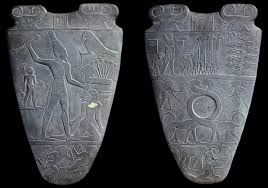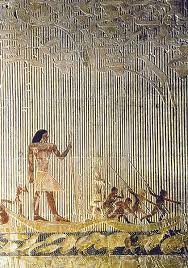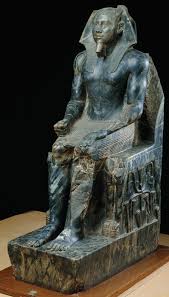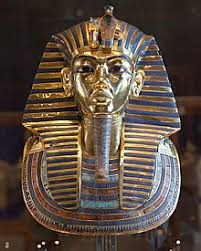Ancient Egypt
1/41
There's no tags or description
Looks like no tags are added yet.
Name | Mastery | Learn | Test | Matching | Spaced |
|---|
No study sessions yet.
42 Terms
Pre-Dynastic
Cosmetic Palette of King Narmer (Period)
Cosmetic Palette of King Narmer

Old Kingdom
Ti Watching a Hippopotamus Hunt (Period)
Ti Watching a Hippopotamus Hunt

Old Kingdom
Great Pyramids (Period)
Great Pyramids

Old Kingdom
Seated Statue of Enthroned King Khafre (Period)
Seated Statue of Enthroned King Khafre

New Kingdom
Funerary Mask of King Tutankhamen (Period)
Funerary Mask of King Tutankhamun

Nile River
Vital part of ancient Egyptian life, providing water for crops, transportation, and other resources.
Osiris
Judge of the dead, symbol of hope, god of fertility, and an embodiment of the dead king.
Horus
God of the sky and kingship
Hathor
Goddess of the sky, mothers, fertility, love, and the dead.
Set
God of chaos, violence, disorder, war, deserts, storms, and foreign lands.
Akhenaten
Pharaoh who established the first monotheistic state religion in the world
Amarna Period
Time of major religious, political, and artistic change.
Elongated
Elongated head shapes were often a way to distinguish individuals or to mark someone as a leader
Monotheism
The belief that there is only one god
Iconography
Used to describe the entirety of ancient Egyptian art and the symbols used in it; colors were used to communicate meaning to the gods
Sunken Relief
Figures are carved into a flat surface, creating an image that is set below the surrounding surface.
Hieroglyphics
Stylized picture of an object representing a word, syllable, or sound, as found in ancient Egyptian and other writing systems.
True Pyramid
Pyramids with smooth sides that maintain the same angle to the top; Designed to have a chamber for the pharaoh's tomb above ground, rather than a burial place below ground.
Rock Cut Tomb
Burial chambers carved into natural rock formations and were a common form of burial for the wealthy
Syncretism
Combining the names and natures of gods with similar characteristics or very different natures to create new composite deities
Ma’at
Egyptian goddess and concept that represented truth, balance, order, justice, harmony, and morality.
Canon of Proportions
Mathematical system used by the ancient Egyptians to create ideal human figures in their art
Stele
A monument made of stone or wood that was used to commemorate people or events, mark boundaries, or access the divine.
Necropolis
Cemetery, especially a large one belonging to an ancient city.
Ka Figure
Statue that provided a resting place for the ka after death
Mastaba
Ancient Egyptian tombs that were rectangular with sloping sides and a flat roof
Step Pyramid
Large architectural structure with a geometric pyramid shape that's made of stacked stone layers and flat platforms that recede from the ground; used as tombs, with tunnels underneath for burying bodies and funerary goods.
Imhotep
Name of an ancient Egyptian polymath who was a mathematician, physician, architect, astrologer, poet, priest, and chief minister to Pharaoh Djoser.
Ka
Life force
Ba
Personality
Akh
Spirit of a deceased person who has been judged and transfigured into a blessed being
Mummification
A complex process used to preserve bodies for the afterlife where it was believed the soul would return to the body
Sarcophagus
Stone coffins or containers to bury the wealthy and leaders
Ashlar Masonry
Type of stone construction that uses uniformly cut stones that are laid in horizontal layers with minimal mortar
Serdab
Chamber in an ancient Egyptian tomb that housed a statue of the deceased
Pharaoh
Ruler of ancient Egypt and was both the head of state and the religious leader of the people
Mastaba → Stepped Pyramid → True Pyramid → Rock Cut Tombs
Evolution of Egyptian Tombs